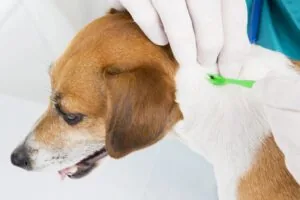Tapeworms in Dogs and Cats

What Are Tapeworms?
Tapeworms are flat, segmented intestinal parasites of the cat and dog. They belong to a different family than other intestinal parasites, such as hookworms and roundworms, which are the other common intestinal parasites of cats and dogs. Several types of tapeworms are known to infect pets, but the most common species observed in cats is Dipylidium caninum.
The tapeworm uses its hook-like mouthparts for anchoring to the wall of the small intestine. Eventually, adult tapeworms reach lengths of up to 11” (30 cm). As the adult tapeworm matures, individual segments called proglottids break off from the main body of the tapeworm and pass in the cat’s feces. The segments resemble grains of rice or cucumber seeds and are about 1/2” (12 mm) long and about 1/8” (3 mm) wide. Occasionally they can be seen moving on the hairs around the anus, or more commonly, on the surface of freshly passed feces. As the proglottid dries, it becomes a golden color and eventually breaks open, releasing the fertilized eggs into the environment. A proglottid may contain as many as 20 tapeworm eggs.
Where Do They Come From?
The most common way for a pet to get tapeworms is from fleas.
Many people who had thought their pet could not possibly have fleas find out about the infestation this way. The tapeworm segment breaks open, releasing its eggs. A larval flea consumes the egg along with the flea dirt that it normally eats. As the larval flea matures, so does the baby tapeworm. When a grooming dog or cat licks the flea and swallows it, the dead flea is digested in the dog’s stomach, releasing the baby tapeworm. The tapeworm is passed to its new home in the dog or cat’s small intestine, where it attaches and lives its life.
This parasite does not harm the pet in any way as there are plenty of nutrients passing by to serve both the host and its tapeworm (tapeworms require very little nutrients.) Still, high performance dogs, who need every calorie working for them, may show a decrease in performance because of a tapeworm infection.
There is another type of tapeworm that may be confused with tapeworms and that is the Taenia genus of tapeworms. This tapeworm has a segment that looks different and has a different mechanism of infection.
What Are the Clinical Signs of Tapeworm Infection?
Tapeworms are not particularly harmful to your pet and few clinical signs are attributed to their presence. Usually, the dog or cat is brought to the veterinarian because the owner notices the presence of proglottids crawling on feces. Rarely, tapeworms may cause debilitation or weight loss if they are present in large numbers. Your pet will occasionally scoot or drag its anus across the ground or carpet due to the anal irritation caused by the proglottids. These proglottid segments look like grains of cooked white rice or cucumber seeds. Less commonly, segments are seen moving around your pets’ anus. Occasionally, a tapeworm will release its attachment in the intestines and migrate to the stomach. When this happens, the cat may vomit an adult tapeworm several inches in length. Because the eggs are passed by the pet in packets (segments), they often do not show up on the fecal exam; the packet must break open for the eggs to be seen. Because of this, you should notify your veterinarian when tapeworm segments are found in your pet’s stool.
Can People Get Them?
The risk of humans getting tapeworms from a dog is minimal because you’d have to swallow an infected flea. However, kids are at a higher risk, especially in environments with heavy flea infestations in the yard or home, or where good personal hygiene isn’t practiced, but this infection is not very serious. Some tapeworms that infect dogs, for instance, the Hydatid tapeworm, can also cause disease in humans. Also try to keep them away from dead animal carcasses. Humans can also get other types of tapeworms not associated with our pets. This can occur when they consume undercooked meat from an infected animal (fish, beef, and pork are the main carriers). Humans might not show any symptoms until years after ingestion. The best prevention of tapeworm infection in humans involves avoiding partially cooked or undercooked meat or meat by-products.
Treatment and Ways to Prevent Tapeworms in Our Pets
Tapeworms are killed by different medications (one is called praziquantel), which is administered by injection, tablet, or topically. The tapeworm is killed and digested with the pet’s food. It is not passed in the stool later.
The good news is, preventing tapeworms in pets is very easy. Here’s how you can make sure your pet remains free of parasites:
- Use flea and tick prevention products. Regular use of these treatments is the best way to prevent tapeworm infestation in your companion. There’s a number of effective products available over-the-counter or by prescription, in oral and topical form. Ask your vet for a recommendation.
- Practice good personal hygiene by washing your hands regularly and teach children to wash their hands after playing with animals to reduce the risk of tapeworm transmission to humans and pets.
- Always pick up your dog’s feces, especially in public parks and playgrounds, in order to minimize the chances for the tapeworm life cycle to continue in the soil.
Share This Post
Recent Posts
About Shallowford Animal Hospital
Shallowford Animal Hospital and The Pet Spa at Shallowford are dedicated to the exceptional, compassionate care your pet deserves. Pets hold a very special place in our families, and we treat yours like our own.



